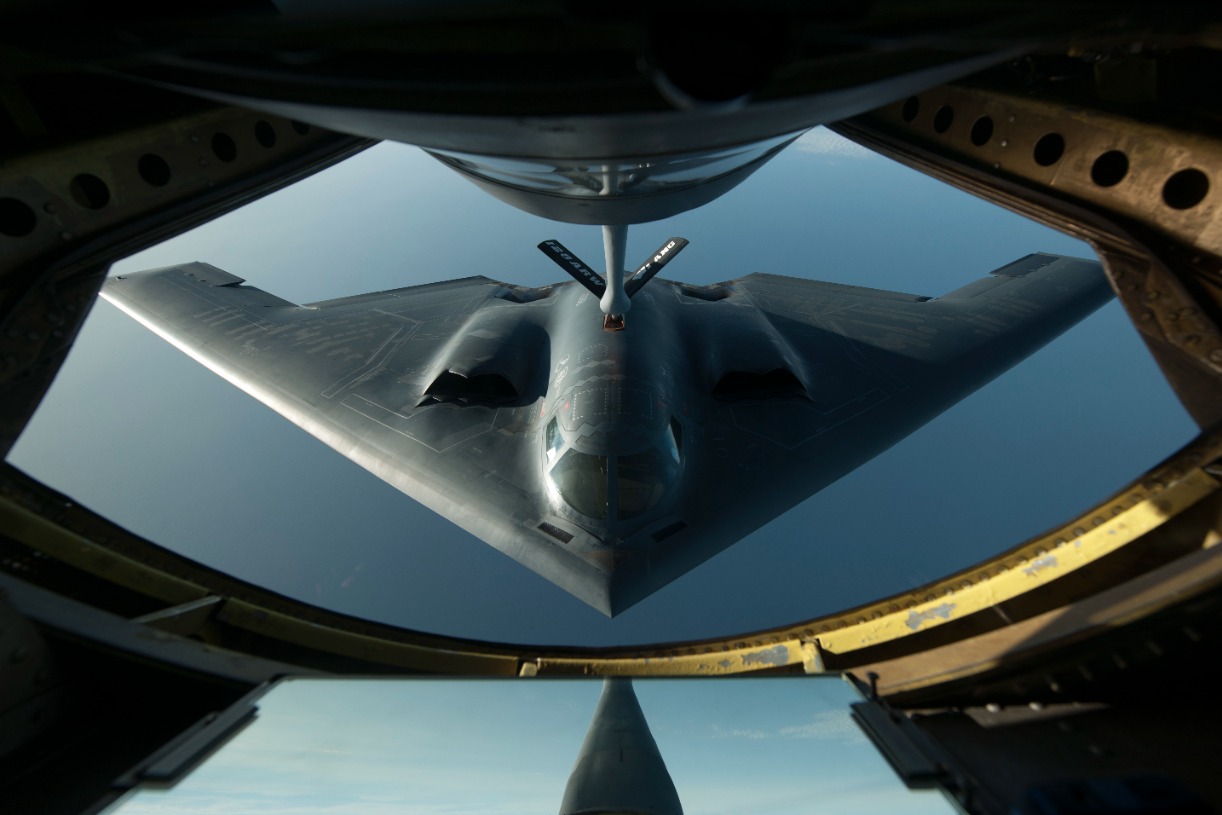Why the B-2 Spirit Stealth Bomber Is the Most Expensive Plane Ever
Despite a futuristic appearance, the B-2 is slated for retirement – to make way for the upcoming B-21 Raider. And while the B-21 looks remarkably similar to the B-2, the B-2’s retirement will mark a sad day for aviation enthusiasts who have spent the last thirty years remarking upon the B-2’s looks and features.
The B-2 Spirit bomber is one of the most distinctive aircraft ever assembled.
Built as a “flying wing” without vertical stabilizers, horizontal stabilizers, or a traditional fuselage, the black-painted B-2 bomber looks like something out of a Batman movie or something from science fiction.
Yet, despite a futuristic appearance, the B-2 is slated for retirement – to make way for the upcoming B-21 Raider.
And while the B-21 looks remarkably similar to the B-2, the B-2’s retirement will mark a sad day for aviation enthusiasts who have spent the last thirty years remarking upon the B-2’s looks and features.
B-2 Spirit: The Most Expensive Airplane Ever
The B-2 bomber has one feature that may make it distinct: exorbitant costs.
In fact, the B-2 is the most expensive airplane ever built.
As the Government Accountability Office reported in 1996, the B-2 bombers “will be, by far, the most costly bombers to operate on a per aircraft basis.”
Indeed, between procurement and maintenance costs, the B-2 is astoundingly expensive.
To put the B2’s operating costs in perspective, consider the costs of America’s other heavy bombers: The B-1 costs about $9 million to operate annually; the B52 costs about $7 million to operate annually. The B-2, meanwhile, costs over $30 million to operate annually.
Why so high? Well, the B-2 requires 119 hours of maintenance for every hour flown. The B-1 and B-52 need just 60 and 53 hours, respectively.
Adding to the B-2s cost further is the need for specialized, $5 million per unit, air-conditioned hangars (used to preserve the B2’s stealth properties) that are large enough to accommodate the B2s 172-foot wingspan.
And all those maintenance fees are in addition to procurement costs. That’s where the B-2 really adds up. The cost per aircraft was over one billion dollars in the 1990s. When adjusted for inflation, each B2 costs about $2 billion.
To put the B2’s price tag in perspective, consider some other USAF airframe price tags.
The F-22 Raptor costs $350 million per unit; The C-17 Globemaster costs $328 million per unit; The P-8 Poseidon costs $290 million per unit; the F-35 Lightning costs $115 million per unit; and Air Force One itself, a modified Boeing 747, costs $660 million.
So, you could buy four Air Force One’s for the price of a single B-2 Spirit. And that right there is why only 21 B2s were ever produced – a drastic reduction from the 132 airframes that were originally planned.
The World’s Most Distinct Aircraft
So, for $2 billion what do you get? The B-2 was designed during the Cold War, with the Soviet Union in mind, to allow for deep penetration missions into enemy territory.
Unlike the U-2 or the SR-71, which had previously been developed to penetrate Soviet airspace (for the purpose of reconnaissance), the B-2 was designed to deliver ordnance – which included nuclear weapons.
Whereas the U-2 had relied upon unreachable altitude (80,000+ feet) to penetrate Soviet airspace, and the SR-71 had relied upon unmatchable speed (2,200 mph) to penetrate Soviet airspace, the B-2 was designed to use stealth technology to sneak across enemy lines.
The B2’s stealth abilities stem from reduced acoustic, infrared, visual, and radar signals – the combination of which allows for the low observability required to evade anti-aircraft defenses. No stone was left unturned: the B2 is even designed to be hard to see with the naked eye as the bomber is painted in an anti-reflective paint with a dark grey underbelly that blends in well with the sky.

Further enhancing the B-2s stealth characteristics is the low-profile, flying wing design, which eliminates many of the angular surfaces found in traditional aircraft designs. In addition to aiding the B2’s stealth characteristics, the flying wing design reduces drag, which improves range – a vital asset for an airframe tasked with deep penetration missions.
Unfulfilled Potential
The B-2 is a venerable aircraft, designed to complete a daunting task at the climax of the US-Soviet showdown. But the Soviet Union dissolved unexpectedly while the B2 was still in development, meaning that by the time the B-2 rolled off the assembly line, it’s primary purpose no longer existed. That’s not to say that the B2 hasn’t served some purpose since its debut.

The existence of the B-2 throughout the 90s and the 00s, while anti-air defenses were still relatively undeveloped, served as a reminder to US enemies that the US had unmatched potential to strike whenever and wherever.
Basically, the B-2 was a geopolitical asset, a looming threat. But as far as tangible application, the B-2 has only been used in a limited role, in instances where, frankly, a lesser airframe would have sufficed.
Now, with the B-2 on the verge of being phased out, it seems unlikely that the B-2 will ever realize its potential – which, from the standpoint of humanity and peace, is, of course, a good thing.
Harrison Kass is a defense and national security writer with over 1,500 total pieces on global affairs issues. An attorney, pilot, guitarist, and minor pro hockey player, Harrison joined the US Air Force as a Pilot Trainee but was medically discharged. Harrison holds a BA from Lake Forest College, a JD from the University of Oregon, and an MA from New York University. Harrison listens to Dokken.
All images are Creative Commons.

